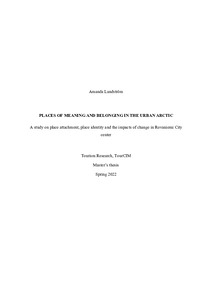Places of meaning and belonging in the urban Arctic: A study on place attachment, place identity and the impacts of change in Rovaniemi City center
Landström, Amanda (2022)
Landström, Amanda
2022
Julkaisun pysyvä osoite on
https://urn.fi/URN:NBN:fi-fe2022062148254
https://urn.fi/URN:NBN:fi-fe2022062148254
Tiivistelmä
Urban places are more than just backgrounds for human activity and interaction, as they are both materially and socially constructed. They are both functional structures and sites of human experience that include memories, emotions and how they are negotiated on an everyday basis. The experience of place is affected by its material, historical and social dimensions and can vary depending on many aspects. Place attachment and place identity are some of the most important actors supporting the development of communities. Urban places have been somewhat neglected in both the academic and policy discussions con-nected to Arctic tourism. As place studies divide into multiple different fields of research, the importance of a more holistic understanding of cities is being stressed.
Rovaniemi is profiled as a tourism city, and the discussions about the places in the city often ask; who are these places made for? This research aims to create understanding on the important elements of place experience from the residents’ point of view; place at-tachment, identity, and the impacts of change are being studied in the context of Rovaniemi city center. The main research question is: How does residents’ place at-tachment form in Rovaniemi city center? The methodology used for data collection was semi-structured photo-elicited interviews. There were altogether 5 participants in this re-search. A qualitative, theory-bound content analysis was used to interpret the data.
The results of this study indicate that in Rovaniemi, the residents’ attachment to places forms through different individual and collective aspects. A common theme is that the residents wish for more communal places within the city as they increase attachment. The meaningful places the participants had chosen had a big impact on their comfort and at-tachment to Rovaniemi. Many residents described their attachment to be constructed by activity and the ability to be close to nature, and especially places of collective and indi-vidual memories became highlighted. Some complexities were described in the attach-ments and place identities as well, as Rovaniemi is seen to be a place of confusing re- and deconstruction that causes detachment and development that only serves some groups.
KEYWORDS: urban place studies, photo-elicitation, place attachment, place identity, Rovaniemi
Rovaniemi is profiled as a tourism city, and the discussions about the places in the city often ask; who are these places made for? This research aims to create understanding on the important elements of place experience from the residents’ point of view; place at-tachment, identity, and the impacts of change are being studied in the context of Rovaniemi city center. The main research question is: How does residents’ place at-tachment form in Rovaniemi city center? The methodology used for data collection was semi-structured photo-elicited interviews. There were altogether 5 participants in this re-search. A qualitative, theory-bound content analysis was used to interpret the data.
The results of this study indicate that in Rovaniemi, the residents’ attachment to places forms through different individual and collective aspects. A common theme is that the residents wish for more communal places within the city as they increase attachment. The meaningful places the participants had chosen had a big impact on their comfort and at-tachment to Rovaniemi. Many residents described their attachment to be constructed by activity and the ability to be close to nature, and especially places of collective and indi-vidual memories became highlighted. Some complexities were described in the attach-ments and place identities as well, as Rovaniemi is seen to be a place of confusing re- and deconstruction that causes detachment and development that only serves some groups.
KEYWORDS: urban place studies, photo-elicitation, place attachment, place identity, Rovaniemi
Kokoelmat
- Pro gradu -tutkielmat [4878]
